By Harold C. Ford
Students in Flint Community Schools (FCS) will miss six days of school in the just-started 2021-22 school year due to the heat. FCS ordered schools closed the entire week of Aug .23-26; an instruction day had not been scheduled for Friday, Aug. 27.
FCS Superintendent Anita Steward issued a revised public statement about school closings on Monday, Aug. 23 on the district’s website that read, in part:
Outside temperatures were expected to be in the 80s (Fahrenheit) through Wednesday and Thursday, according to The Weather Channel and AccuWeather websites.
Flint school buildings average 70 years old
The eleven FCS buildings that currently house students in grades K-12 are, collectively an average of 70 years old, according to information provided East Village Magazine by the Flint-based Sloan Museum.
The opening dates, and ages of each building are: Southwestern, 1959, 62 years; Scott, 1961, 60; Holmes, 1962, 59; Neithercut, 1961, 60; Potter, 1952, 69; Doyle/Ryder, 1901, 120; Durant-Tuuri-Mott, 1922, 99; Pierce, 1952, 69; Brownell, 1963, 58; Eisenhower, 1966, 55; Freeman; 1951, 70.
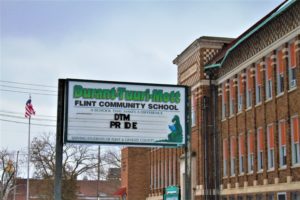
Durant-Tuuri Mott school on University Ave near Kettering University. (Photo by Tom Travis)
The FCS buildings average 70 years old.
Average age of buildings in U. S. is 44 years
“A majority of schools surveyed by the National Center for Education Statistics (76 percent) said school buildings were in ‘good’ to ‘excellent’ condition,” according to the Education Week report.
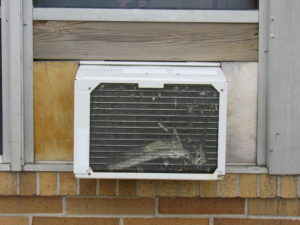
Window air conditioner at a Flint school building; 110 classrooms still need these units. (Photo by H. C. Ford)
Large percentages reported aspects of school facilities to be “fair” or “poor”: air conditioning, 30 percent; heating, 30 percent; plumbing/restrooms, 31 percent; roofs, 25 percent; windows, 32 percent; sidewalks, 27 percent; playgrounds/play areas, 27 percent.
The average combined spending for capital projects and maintenance and operations in the nation’s schools is $99 billion each year.
Flint’s infrastructure shortcomings and needs
Infrastructure shortcomings and needs — HVAC systems (heating, ventilation, air conditioning), electrical grids, hydration stations or smart water fountains, internet capabilities, outdated plumbing, crumbling athletic facilities, – and how to pay for upgrades in those areas have dominated portions of recent FBOE meetings.
At the Aug. 18 FBOE meeting, Danielle Green, board secretary, summarized, “All our buildings gotta be renovated.”

Danielle Green, FCS board Secretary. (Photo source: FCS website)
Board members learned from their financial officers at the August board meetings that COVID relief funds are not likely sufficient for the district’s massive infrastructure needs.
Ayunna Dombreh, executive director of finance, told the board at its Aug. 11 meeting, “They (the federal government) highly, highly discourage using these funds for new construction.”

Ayunna Dompreh, FCS executive director of finance
Though hopeful, no FCS official has yet claimed the just-started process of selling abandoned properties and run-down buildings will generate sufficient funds for needed upgrades or replacement of FCS buildings.
Mott Foundation offer to resurrect buildings nowhere on board’s agenda
Nonetheless, a $200-million-plus offer by the Flint-based Charles Stewart Mott Foundation to rebuild or renovate all of Flint’s schools is nowhere to be found on FCS board agendas.
Ridgway White, Mott Foundation CEO, appeared before the FBOE on June 28 and invited the board to partner on the building of new schools. “I’m asking for you to allow us to partner with you, to talk with you …”
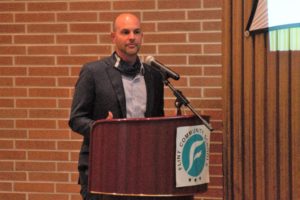
C.S. Mott Foundation President and CEO Ridgway White speaking at a June 2021 FCS board meeting. (Photo by Tom Travis)
At the same meeting, Diana Wright, board trustee, clashed with Carol McIntosh, board president, over Wright’s suggestion that the proposal by the Mott Foundation be put on the July 2021 board agendas. “It is my expectation that this agenda item is on the July agenda,” insisted Wright.
“It will not be on the July agenda,” McIntosh replied. In fact, the Mott proposal has not appeared on any of the board’s July and August agendas.
Lost school days
At its Aug. 18 meeting, board of education members inquired about the number of lost instruction days allowed by the Michigan Department of Education (MDE) before they would have to be made up.
“We get six days that are forgiven,” said Steward. FCS stands to lose significant state aid for any days beyond six that are not “forgiven” or made up.

FCS has, thus far, canceled six days in the 2021-22 school year due to the heat. On three other days, a minimum level of 75 percent student attendance was not achieved. The district is now three days beyond the number of days that will be forgiven by the state.
At the Aug. 18 meeting, one board member suggested virtual learning as an alternative to closing schools due to heat.
Steward advised the board that, following the unusual 2020-21 school year altered by the COVID pandemic, MDE no longer allows a blanket option for virtual learning for an entire school district. She said she would explore the possibility of a virtual leaning exemption with MDE. Otherwise, districts are now allowed a single school day for districtwide virtual learning.
Some board members suggested exchanging missed instruction days for intersession days. The district’s first intersession break occurs Sept. 7-10, according to the calendar posted at the district’s website.
“That’s a negotiable item with the bargaining units,” advised Ayunna Dompreh, FCS executive director of finance.
The board then voted 4-1 to reopen discussions with the FCS unions about the school calendar.
“Unbearable”
The board’s newest member, Adrian Walker, had heard the complaints about the heat. He reported on his subsequent visits to Brownell STEM Academy and Holmes STEM Middle School Academy this past week.
“It’s just unbearable,” Walker said. “There’s no way you can learn in that environment.”
Dan Mack, an account manager with Johnson Controls, a company that is attempting to upgrade the HVAC systems at FCS buildings, agreed with Walker’s assessment.
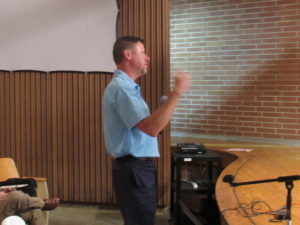
Dan Mack, account manager with Johnson Controls, speaks to the FCS board at their last meeting. (Photo by Harold Ford)
“It’s difficult to learn in that environment,” Mack told board members. “I couldn’t do it.”
“What can we do to make it right for our babies?” asked Marlis Settle, an attendance agent at Brownell. “Our children are suffering from the heat.”
Nearly in tears at times, Settle told board members she wrapped bits of ice in paper towels and distributed them to students looking for relief from the heat. She also reported that bottled water provided students was warm due to lack of refrigeration.
Settle reported that some teachers shut ceiling lights off in attempts to lower temperatures in their classrooms. And use of window air-conditioning units often caused electrical circuits to break, the result of an aging electrical infrastructure. Further, noise from the use of fans made teaching difficult.
“They can’t learn,” Settle said. “I would prefer for us to keep them babies out ’til Labor Day.”
Balanced calendar
Green advised a pause in the balanced calendar which starts the school year earlier, finishes later, and features more frequent breaks, intersessions, during the school year.
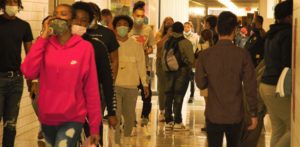
Students at Flint’s Southwestern Academy fill the hallways between classes. (Photo by Tom Travis)
Flint schools are in the third year of balanced calendars after the concept was adopted for the 2019-20 school year.
Many advantages are cited by proponents of the balanced calendar, notably lessening summer vacation learning loss for economically disadvantaged students.
The national trend is toward balanced calendars. As early as Oct. 2014, Education Week reported “The number of public year-round schools increased by 26 percent, to 3,700 from 2006-07 to 2011-12 …”
Nonetheless, a balanced calendar also means that students will be in classrooms during the warmest months of the calendar year. Flint’s high temperatures average 80 degrees in August, according to U.S. Climate Data.

A masked student walks into their first day of school at Doyle-Ryder School. (Photo by Tom Travis)
Prior to becoming the first school district in the state to adopt a balanced calendar in 2013-2014, Flint’s immediate neighbor to the north, Beecher, proactively provided funding for upgraded climate control systems in its buildings. Beecher also held meetings with students, staff, and parents to pitch the advantages of a balanced calendar.
What happened in Beecher did not happen in Flint, a system beset with aging infrastructure and financial shortcomings. And poor student attendance signals a community not wholly convinced of the benefits of a balanced calendar.
Mack cautioned board members that December 2021 is the earliest possible completion date for HVAC upgrades to provide air-conditioning to all FCS buildings. “Unfortunately, we will not have air-conditioning units completed this year,” advised Mack.
It’s not just a matter of installing AC units. “Electrical service is still an issue,” said Mack.
An aging infrastructure derailed Steward’s plans to put window AC units in the 110 classrooms that do not have them. She said aging electrical infrastructure and the cost and labor for needed ventilation made that plan impracticable.
“Every time we come up with a thought, we get a roadblock,” said a chagrinned Steward. “I’m trying to do what I can to cool off these classrooms.”
Despite their noise, Steward said the district may purchase large fans for the hallways and classrooms.
“Putting the kids at risk”
“My concern is we’re putting the kids at risk,” said Ellis-McNeal. “We cannot sit here and pretend we do not have an emergency situation.”
“We can’t keep subjecting people to this type of treatment,” agreed McIntosh. “We haven’t fixed our issue and our kids are suffering.”
EVM Education Beat reporter Harold Ford can be reached at hcford1185@gmail.com.


You must be logged in to post a comment.